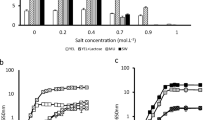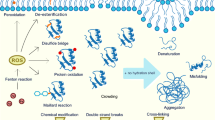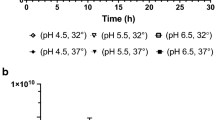Abstract
Pathogenic microorganisms surviving in dry products are responsible for numerous foodborne disease outbreaks, but a complete understanding of physiological survival mechanisms is still lacking. The response of pathogens to low water activity is very complex and involves immediate physiological actions of the cell as well as a coordinated genetic response. Compatible solutes, such as trehalose, may play an important role in bacterial survival, but, as has been shown for Cronobacter spp., trehalose-negative strains survived dry stress as well as the wild-type strains, suggesting that other mechanisms may play a role. Another contributing factor thought to be associated with resistance to drying is the production of extracellular polysaccharides (EPS); nevertheless, it has also been shown that the role of EPS in drying tolerance is not clear-cut and that additional research is needed to understand its role in resistance against drying. The coordinated genetic response of bacteria to stress involves multiple regulons or specific genes (O’Byrne and Booth, Int J Food Microbiol 74:203–216, 2002; Pichereau et al., Int J Food Microbiol 55:19–25, 2000; Riedel and Lehner, Proteomics 7:1217–1231, 2007). However, to elucidate the exact role of the various genes in bacterial dry stress resistance will likely keep researchers busy for a very long time. In the last decade some sectors within the food industry have responded by significantly improving the hygiene in dry areas of food processing facilities by, for example, introducing strict dry cleaning procedures and better attention to hygienic zoning. A comprehensive approach has been developed and published by microbiologists through the Grocery Manufacturers Association (Scott et al., Food Prot Trends 342–353, 2009a, Scott et al., Food Prot Trends 435–445, 2009b; Chen et al., Food Prot Trends 493–434, 2009).
Access this chapter
Tax calculation will be finalised at checkout
Purchases are for personal use only
Similar content being viewed by others
References
Arku B, Mullane N, Fox E, Fanning S, Jordan K (2008) Enterobacter survives spray drying. Int J Dairy Technol 61:102–108
Barron CB, Forsythe SJ (2007) Dry stress and survival time of Enterobacter sakazakii and other Enterobacteriaceae in dehydrated powdered infant formula. J Food Prot 2007:2111–2117
Burnett S, Gehm ER, Weissinger WR, Beuchat LR (2000) Survival of Salmonella in peanut butter and peanut butter spread. J Appl Microbiol 89:472–477
Breeuwer P, et al. Unpublished results.
Breeuwer P, Lardeau A, Peterz M, Joosten HM (2003) Desiccation and heat tolerance of Enterobacter sakazakii. J Appl Microbiol 95:967–973
CAC (Codex Alimentarius Commission) (2008) Code of hygiene practice for powdered formulae for infants and young children. CAC/RCP 66. World Health Organization-Food and Agriculture Organization of the United Nations, Rome, Italy
Chen Y, Scott VN, Freier TA, Kuehm J, Moorman M, Meyer J, Morille-Hinds T, Post L, Smoot L, Hood S, Shebuski J, Banks J (2009) Control of Salmonella in low-moisture foods III: process validation and environmental monitoring. Food Prot Trends. 493–434
Crowe JH, Hoekstra FA, Crowe LM (1992) Anhydrobiosis. Annu Rev Physiol 54:579–599
Dancer GI, Mah JH, Rhee MS, Hwang IG, Kang DH (2009) Resistance of Enterobacter sakazakii (Cronobacter spp.) to environmental stresses. J Appl Microbiol 107:1606–1614
Diep B (2006) Unpublished results. Nestlé Research Centre, Lausanne, Switzerland
Dodd CER, Aldsworth T (2002) The importance of RpoS in the survival of bacteria through food processing. Int J Food Microbiol 74:189–194
FAO/WHO Food and Agriculture Organization/World Health Organization (2004) Enterobacter sakazakii and other microorganisms in powdered infant formula: meeting report. MRA Series 6. www.who.int/foodsafety/micro/meetings/feb2004/en/ (Online)
Garmiri PKE, Coles TJH, Cogan TA (2008) Role of outer membrane lipopolysaccharides in the protection of Salmonella enterica serovar Typhimurium from desiccation damage. FEMS Microbiol Lett 281:155–159
Gomez Zavaglia A, Tymczyszyn E, de Antoni G, Anibal Disalvo E (2003) Action of trehalose on the preservation of Lactobacillus delbrueckii ssp. bulgaricus by heat and osmotic dehydration. J Appl Microbiol 95:1315–1320
Hengge-Aronis R, Klein W, Lange R, Rimmele M, Boos W (1991) Trehalose synthesis genes are controlled by the putative sigma factor encoded by rpoS and are involved in stationary phase thermotolerance in Escherichia coli. J Bact 173:7918–7924
Hiramatsu R, Matsumoto M, Sakae K, Miyazaki Y (2005) Ability of shiga toxin-producing Escherichia coli and Salmonella spp. to survive in a desiccation model system and in dry foods. Appl Env Microbiol 71:6657–6663
Kandhai MC, Reij MW, Gorris LGM, Guillaume-Gentil O, van Schothorst M (2004) Occurrence of Enterobacter sakazakii in the food production environments and households. Lancet 363:39–40
Knowles EJ, Castenholz RW (2008) Effect of exogenous extracellular polysaccharides on the desiccation and freezing tolerance of rock-inhabiting phototrophic microorganisms: effect of EPS on tolerance of rock-inhabiting phototrophs. FEMS Microbiol Ecol 66:261–270
Komitopoulou E, Peñaloza W (2009) Fate of Salmonella in dry confectionary raw materials. J Appl Microbiol 106:1892–1900
Lehner A, Riedel K, Eberl L, Breeuwer P, Diep B, Stephan R (2005) Biofilm formation, extracellular polysaccharide production, and cell-to-cell signaling in various Enterobacter sakazakii strains: aspects promoting environmental persistence. J Food Prot 68:2287–2294
Morgan CA, Herman N, White PA, Vesey G (2006) Preservation of microorganisms by drying; a review. J Microbiol Methods 66:183–193
Mullane N, Whyte P, Wall PG, Quinn T, Fanning S (2007) Application of pulsed-field gel electrophoresis to characterize and trace the prevalence of Enterobacter sakazakii in an infant formula processing facility. Int J Food Microbiol 116:73–81
Mullane N, Healy B, Meade J, Whyte P, Wall PG, Fanning S (2008) Dissemination of Cronobacter spp. (Enterobacter sakazakii) in a powdered milk protein manufacturing facility. Appl Environ Microbiol 19:5913–5917
O’Byrne CP, Booth IR (2002) Osmoregulation and its importance to food-borne microorganisms. Int J Food Microbiol 74:203–216
Ophir T, Gutnick DL (1994) A role of exopolysaccharides in the protection of microorganisms from desiccation. Appl Environ Microbiol 60:740–745
Pagotto FJ, Nazarowec-White M, Bidawid S, Farber JM (2003) Enterobacter sakazakii: infectivity and enterotoxin production in vitro and in vivo. J Food Prot 66:370–375
Pichereau V, Hartke A, Auffray Y (2000) Starvation and osmotic stress induced multiresistances: influence of extracellular compounds. Int J Food Microbiol 55:19–25
Potts M (1994) Desiccation tolerance of prokaryotes. Microbiol Rev 58:755–805
Potts M (2001) Desiccation tolerance: a simple process? Trends Microbiol 9:553–559
Riedel K, Lehner A (2007) Identification of proteins involved in osmotic stress response in Enterobacter sakazakii by proteomics. Proteomics 7:1217–1231
Scott VN, Chen Y, Freier TA, Kuehm J, Moorman M, Meyer J, Morille-Hinds T, Post L, Smoot L, Hood S, Shebuski J, Banks J (2009a) Control of Salmonella in low-moisture foods I: minimizing entry of Salmonella into a processing facility. Food Prot Trends. 342–353
Scott VN, Chen Y, Freier TA, Kuehm J, Moorman M, Meyer J, Morille-Hinds T, Post L, Smoot L, Hood S, Shebuski J, Banks J (2009b) Control of Salmonella in low-moisture foods II: hygiene practices to minimize Salmonella contamination and growth. Food Prot Trends. 435–445
Sleator RD, Hill C (2001) Bacterial osmoadaptation: the role of osmolytes in bacterial stress and virulence. FEMS Microbiol Rev 26:49–71
Tamminga SK, Beumer RR, Kampelmacher EH, van Leusden FM (1976) Survival of Salmonella eastbourne and Salmonella typhimurium in chocolate. J Hygiene 76:41–47
Tamaru Y, Takani Y, Yoshida T, Sakamoto T (2005) Crucial role of extracellular polysaccharides in desiccation and freezing tolerance in the terrestrial cyanobacterium Nostoc commune. Appl Environ Microbiol 71:7327–7333
Welsh DT, Herbert RA (1999) Osmotically induced intracellular trehalose, but not glycine betaine accumulation promotes desiccation tolerance in Escherichia coli. FEMS Microbiol Lett 174:57–63
Yim HH, Villarejo M (1992) osmY, a new hyperosmotically inducible gene, encodes a periplasmic protein in Escherichia coli. J Bacteriol 174:3637–3644
Author information
Authors and Affiliations
Corresponding author
Editor information
Editors and Affiliations
Rights and permissions
Copyright information
© 2014 Springer Science+Business Media New York
About this chapter
Cite this chapter
Breeuwer, P. (2014). Adaptation of Pathogenic Microorganisms to Dry Conditions. In: Gurtler, J., Doyle, M., Kornacki, J. (eds) The Microbiological Safety of Low Water Activity Foods and Spices. Food Microbiology and Food Safety(). Springer, New York, NY. https://doi.org/10.1007/978-1-4939-2062-4_3
Download citation
DOI: https://doi.org/10.1007/978-1-4939-2062-4_3
Published:
Publisher Name: Springer, New York, NY
Print ISBN: 978-1-4939-2061-7
Online ISBN: 978-1-4939-2062-4
eBook Packages: Chemistry and Materials ScienceChemistry and Material Science (R0)




